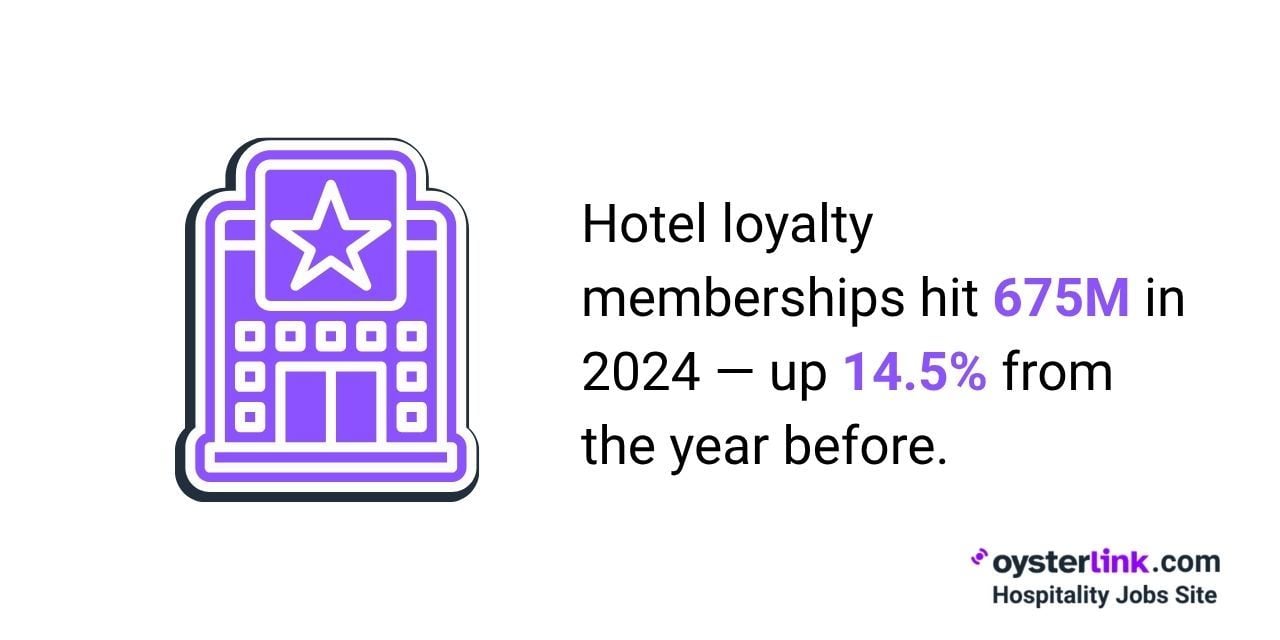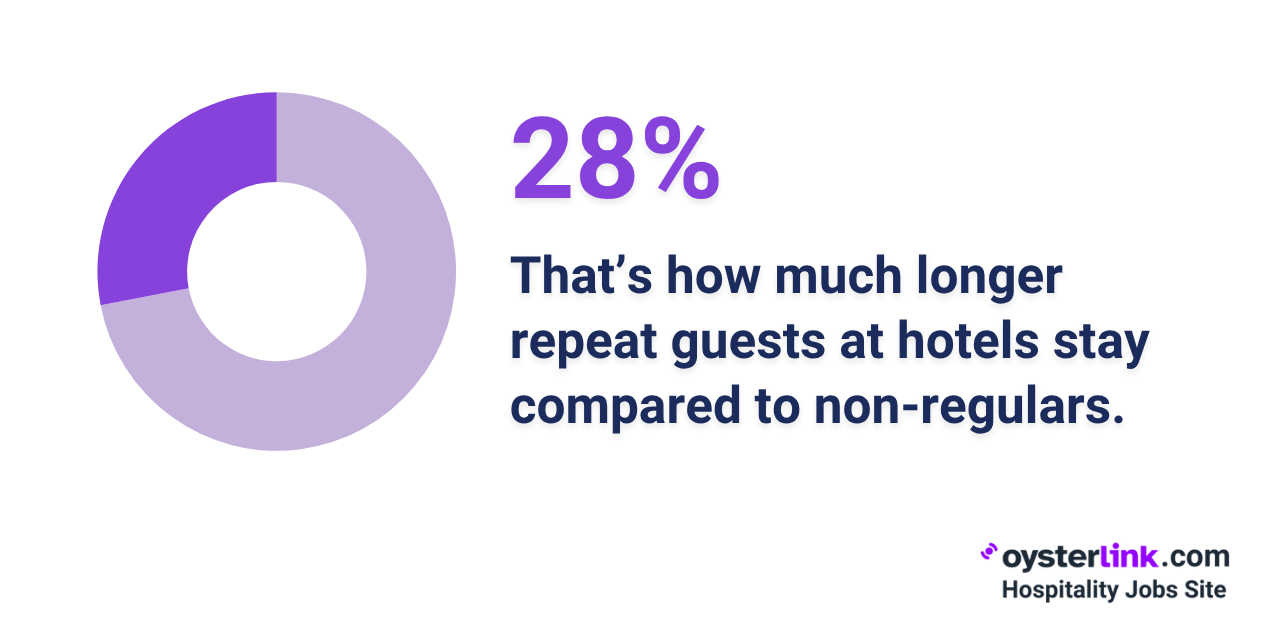Hotel Loyalty Programs: Key Findings
- Hotel loyalty memberships hit 675 million in 2024, up 14.5%, outpacing 6.7% room growth.
- There are now 137 loyalty members per available room, a 7.4% increase.
- Average liability per member fell 5.3%, from $18.85 to $17.85, reflecting tighter cost control.
- Loyalty liabilities rose 8.4% to $2.4 billion; revenues rose 8.3% to $1.2 billion.
Hotel loyalty rewards programs have evolved from basic incentives into powerful drivers of bookings, brand loyalty and guest engagement. They now play a central role in how hotels build relationships and compete for repeat business.
This report breaks down the latest hotel loyalty program statistics and what they mean for the industry.
Hotel Loyalty Program Memberships Are Surging Past Room Growth
Loyalty membership refers to the number of individuals enrolled in hotel-branded rewards programs. These members earn points or benefits in exchange for repeat stays and engagement with the brand.
Hotel loyalty program membership across major global brands — including Marriott, Hilton, IHG and others — reached 675 million in 2024, a 14.5% increase from the previous year.

For comparison, hotel room supply only grew by 6.7% during the same period. This means that loyalty programs are growing more than twice as fast as new hotel construction.
There are now 137 loyalty members per available room, up 7.4% from 2023. This ratio shows that guest engagement is becoming less dependent on adding new rooms and more focused on making the most of each guest who stays.
In short, hotels are increasingly investing in loyalty as a long-term strategy to generate repeat business and improve overall profitability.
Financial Weight of Hotel Loyalty Programs
Hotel loyalty programs come with real financial considerations for operators.
The average liability per member refers to how much a hotel expects to eventually spend on rewards for each enrolled guest. In 2024, this liability dropped by 5.3%, from $18.85 to $17.85.
This reduction suggests hotels are fine-tuning their programs to manage costs more effectively without losing guest interest.
Hotels are refining how rewards are structured — adjusting point values, introducing expiration dates or encouraging redemptions with lower financial impact. These strategies help balance guest satisfaction with cost control.
That $17.85 liability now represents 11.3% of the average daily rate (ADR) — the average revenue earned per occupied room. This share is down significantly from 21.9% in 2016, pointing to a more sustainable rewards model.
However, while the cost per guest has dropped, total program expenses have risen due to a growing number of participants. Loyalty revenues grew 8.3% to $1.2 billion, while liabilities increased 8.4% to $2.4 billion.
The cost per occupied room (CPOR) for loyalty programs now averages $5.46, accounting for 1.6% of total hotel revenue — slightly up from 1.58% in 2023.
This shows that while individual costs are better controlled, the scale of participation continues to drive overall expenses upward.
How Hotel Loyalty Program Members Boost Guest Spend
The value of loyalty programs shows up clearly in guest behavior. Repeat guests:
- Spend 22.4% more than non-members
- Stay 28% longer on average

These behaviors help hotels drive more predictable revenue and foster longer-term relationships with their most engaged customers.
Largest Hotel Loyalty Programs in 2025
Some of the world’s most recognized hotel chains have built massive loyalty programs with tens or even hundreds of millions of members.
These programs play a major role in how brands retain guests, encourage direct bookings and drive repeat business.
Hotel Loyalty Program | Membership (in millions) |
| World of Hyatt | 46 |
| Choice Privileges | 65 |
| Accor Live Limitless | 89 |
| Wyndham Rewards | 108 |
| IHG Rewards | 130 |
| Hilton Honors | 190 |
| Marriott Bonvoy | 203 |
These brands represent the largest hotel loyalty programs globally and account for the majority of member activity. Their offerings go beyond discounts — featuring digital check-ins, late checkouts, elite status tiers, lounge access and airline partnerships.
Hotels use these benefits to stand out in a competitive market and build long-term relationships with returning guests.
What Motivates Travelers To Join Hotel Loyalty Programs?
Travelers join loyalty programs for more than just earning points — they’re often looking for personalized benefits and a deeper connection with the brand.
- 84% of loyalty members say these programs increase their overall sense of brand loyalty.
- 66% of consumers report that earning rewards influences how they spend.
- Loyalty members are 70% more likely to choose the same hotel brand over competitors.
These stats show that while loyalty can be powerful, brands still risk losing customers if their programs fall short of expectations.
What’s Next for Hotel Loyalty Programs?
As of 2025, hotel loyalty rewards programs are continuing to evolve in response to guest expectations and digital trends. Future-forward strategies include:
- Personalization based on booking and stay history
- Dynamic pricing and exclusive flash offers for members
- Seamless in-app redemptions and upgrades
- Partnerships with transportation, dining, and entertainment brands
- Flexible point redemptions and experiential rewards
Programs like Accor Live Limitless are setting the pace in this area, with strong integrations in lifestyle, dining, and entertainment experiences.
In the long game of hospitality, loyalty is no longer a nice-to-have. It’s the foundation of a modern hotel’s revenue and retention strategy.
Final Thoughts on Hotel Loyalty Program
It’s been more than four decades since the first hotel rewards program was introduced in 1983 by Holiday Inn with its Priority Club Rewards.
That launch set the stage for a wave of innovation across the industry, including Marriott’s entry later that same year.
What began as a simple way to encourage repeat bookings has evolved into a multi-billion-dollar ecosystem influencing traveler behavior, marketing strategies, and hotel profitability.
From massive membership growth to measurable gains in guest value and direct bookings, hotel loyalty programs are driving real business results.
For Hotel Managers, ignoring loyalty is no longer an option. And for those who invest in smart, data-driven programs — the payoff is clear.










Loading comments...